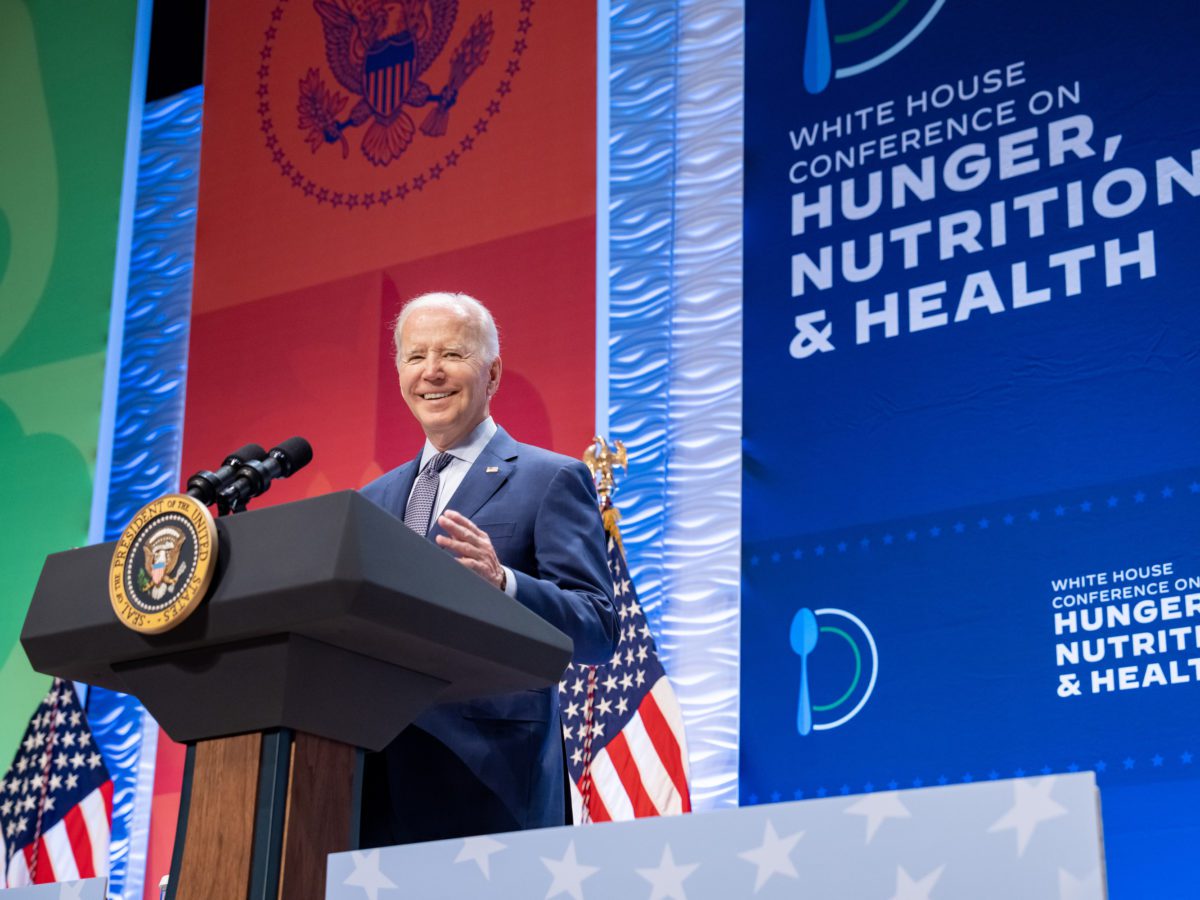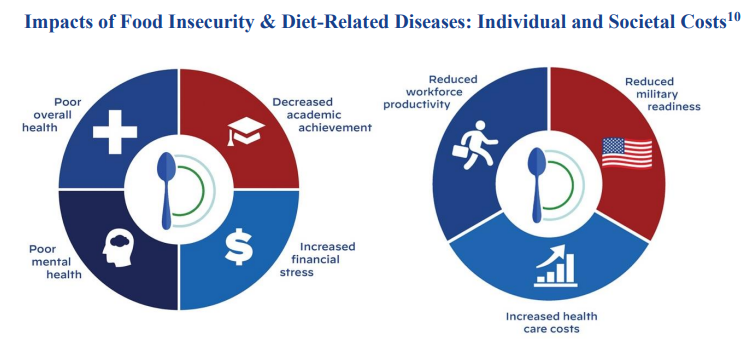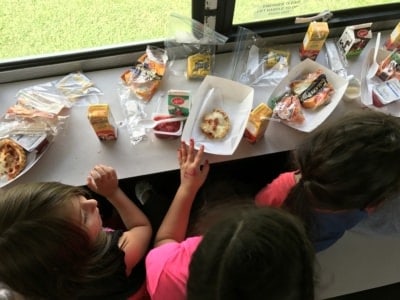
Share this story
- For the first time since the pandemic began, N.C. students don’t have universal access to free school meals. The White House unveiled a plan this week to change that. #nced
- The @WhiteHouse hosted the #WHConfHungerHealth, aimed at ending hunger & increasing healthy eating by 2030. The national strategy to get there included a plan to provide free school meals for all students. #nced
|
|
On Sept. 28, the Biden-Harris Administration hosted the White House Conference on Hunger, Nutrition and Health, aimed at ending hunger and increasing healthy eating and physical activity by 2030 for all Americans. The administration’s national strategy to address these issues, introduced at the conference, include the advancement of a pathway toward free healthy school meals for all students.
“Over the next 10 years, my plan…would make at least 9 million more children eligible for free school meals, a major first step for free meals for every single student,” said President Joe Biden, who also said the plan would promote supporting schools so they can cook more meals from scratch and purchase more food from local farmers and ranchers.
The Biden-Harris Administration also pledged to promote the expansion of summer Electronic Benefits Transfer (EBT) benefits to more children so they can continue to access nourishing meals when school is not in session, and to expand Supplemental Nutrition Assistance Program (SNAP) eligibility to more underserved populations. The national strategy also promotes the continuation of the expanded Child Tax Credit, which the administration implemented through the American Rescue Plan during the pandemic and, the administration says, helped to cut child poverty by nearly 50 percent.
The effort to expand more free school meals to children across the country as well as fulfill the other pledges made in the national strategy plan would rely on bipartisan support and new legislative action in Congress – as well as assistance from other community partners – in order to come to fruition. Biden said he had roughly $8 billion in commitments from more than 100 different organizations in order to help the administration meet their goals to end hunger and improve Americans’ health.
“I feel incredibly optimistic about healthy school meals for all being on [the administration’s] list of priorities,” said Andrew Harrell, program and communication manager for No Kid Hungry NC and the Carolina Hunger Initiative. “We certainly hope there will be bipartisan support for changing these policies in a way that will greatly reduce stigma and make meals easier to access for all children, because we know that healthy school meals are both a health intervention as well as an academic intervention.”
School meals are a health and academic intervention
It has been more than 50 years since President Richard Nixon convened the first and only other White House conference on hunger and nutrition. While the United States has made significant progress since then, U.S Secretary of Agriculture Tom Vilsack said on Wednesday that food and nutrition insecurity still remains unacceptably high.
“I want to highlight the proposed pathway to the national strategy for healthy school meals for all,” said Vilsack during his opening remarks. “This is a core intervention to improve child hunger and health, and recent research demonstrates that school meals provide the healthiest food a child eats during the day. The proposal reorients this important program as a key health tool to provide the highest quality meals and to engage children around healthy choices.”
For the first time since the start of the pandemic, students in North Carolina are walking into school buildings this year without universal access to free school meals. Instead, households must qualify for free school meals based on income requirements, except in high poverty schools and districts where the Community Eligibility Provision applies and every student in that district or school eats for free. There are also some schools and districts that have found alternative funding to keep breakfast free.
[Want to know the nuts and bolts about how school meals are funded? Read our school meals primer!]
“When families can’t afford healthy food options, it’s harder for children to succeed in school, and it can lead to mental and physical health challenges for the whole family,” Biden said in the preface to his national strategy plan for addressing hunger, nutrition and health.
“For so many families—including families of color, those living in rural communities and territories, and low-income families—structural inequality, such as disparities in educational and economic opportunities and lack of access to health care, safe housing, and transportation, make the impact of hunger and diet-related diseases even more severe,” Biden said.
The five pillars of action to end hunger and improve health

The administration’s national approach to tackling the broad issues of hunger, nutrition, and health includes five different pillars of action, and all of the details of those pillars can be found in this national strategy document. A brief summary of some of those details is below, laid out explicitly in the administration’s executive summary.
Pillar One: Improving food access and affordability, including by advancing economic security; increasing access to free and nourishing school meals; providing Summer Electronic Benefits Transfer (EBT) benefits to more children; and expanding Supplemental Nutrition Assistance Program (SNAP) eligibility to more underserved populations;
These five pillars are outlined as above in the Executive Summary of the Biden-Harris Administration National Strategy on Hunger, Nutrition, and Health
Pillar Two: Integrating nutrition and health, including by working with Congress to pilot coverage of medically tailored meals in Medicare; testing Medicaid coverage of nutrition education and other nutrition supports using Medicaid section 1115 demonstration projects; and expanding Medicaid and Medicare beneficiaries’ access to nutrition and obesity counseling;
Pillar Three: Empowering all consumers to make and have access to healthy choices, including by proposing to develop a front-of-package labeling scheme for food packages; proposing to update the nutrition criteria for the “healthy” claim on food packages; expanding incentives for fruits and vegetables in SNAP; facilitating sodium reduction in the food supply by issuing longer-term, voluntary sodium targets for industry; and assessing additional steps to reduce added sugar consumption, including potential voluntary targets;
Pillar Four: Supporting physical activity for all, including by expanding the U.S. Department of Health and Human Services’ Centers for Disease Control and Prevention’s (CDC) State Physical Activity and Nutrition Program to all states and territories; investing in efforts to connect people to parks and other outdoor spaces; and funding regular updates to and promotion of the Physical Activity Guidelines for Americans; and
Pillar Five: Enhancing nutrition and food security research, including by bolstering funding to improve metrics, data collection, and research to inform nutrition and food security policy, particularly on issues of equity and access; and implementing a vision for advancing nutrition science.
Notably, Pillar One also calls on state and local school districts to increase investments in programs such as supporting improved kitchen infrastructure and training school nutrition professionals, as well as encouraging philanthropic partners to fund “pilots that foster collaboration between food service programs at K-12 schools and colleges or universities in order to synergize efforts around workforce training and food procurement.”
What does all of this mean for North Carolina’s students?
The White House’s plan to end hunger presented many big goals, but there remain questions on how their impacts would be realized at the local level. In the months ahead as the administration works on getting legislation introduced, advocates and agency officials will be diving deeper into the details to get a better understanding of how North Carolina can benefit from this national strategy.
Lynn Harvey, director of school nutrition services at the N.C. Department of Public Instruction, said the creation of a pathway toward universal free school meals is a critical strategy that she welcomes.
“Meals at school are an important part of the instructional day because they promote optimal student health, well-being, academic and future success, which is a key component of Superintendent Truitt’s Operation Polaris,” said Harvey. “When students’ bodies, minds, and souls are well-nourished, they perform better in the classroom, have fewer behavioral issues that distract from learning, and are able to engage in the growth opportunities available to them at school.”
Carolina Hunger Initiative’s Harrell said his team will be looking at the Biden-Harris Administration’s national strategy in the next few weeks to determine how it will impact North Carolina’s students and how they can mobilize around the calls to action laid out in the plan.
“We’ll be hosting a follow up discussion in the next few weeks that will be focused on the impact that this plan will have on child nutrition programs specifically in North Carolina,” said Harrell.





